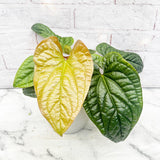30 - 40cm Anthurium Vanilla Flower 12cm Pot House Plant
Anthuriums, commonly known as Flamingo Flowers, are popular and striking houseplants known for their glossy foliage and bright, heart-shaped flowers. Here's a detailed guide to care for your Anthurium:
-
Light: Anthuriums prefer bright, indirect light. Too much direct sunlight can cause leaf burn, while too little light can lead to leggy growth and reduced flowering.
-
Water: Anthuriums prefer their soil to be consistently moist, but not waterlogged. Overwatering can lead to root rot, a common problem in Anthuriums. Water your plant thoroughly, then allow the top 1-2 inches of soil to dry out before watering again.
-
Humidity: Anthuriums are tropical plants and thrive in high humidity. If the air in your home is too dry, consider using a humidifier, placing your plant on a tray filled with pebbles and water (making sure the plant isn't sitting directly in the water), or misting the plant regularly.
-
Soil: Anthuriums need well-draining soil to prevent waterlogging and root rot. A good mix is a high-quality orchid mix, which is usually made of fir bark, perlite, and peat. Alternatively, you can make your own mix with equal parts peat moss, perlite, and pine bark.
-
Temperature: Anthuriums prefer temperatures between 60°F and 85°F. They don't tolerate frost or temperatures below 55°F well.
-
Fertilizer: Feed your Anthurium with a balanced, water-soluble fertilizer diluted to half strength every two weeks during the growing season (spring and summer). In the fall and winter, reduce fertilizing to once a month.
-
Repotting: Anthuriums typically need to be repotted every two to three years, or when the roots have filled the pot. The best time to repot is in the spring.
-
Pest Control: Keep an eye out for common houseplant pests like aphids, mealybugs, and spider mites. If you notice any pests, treat with an appropriate insecticide or neem oil.
-
Flowering: The bright, heart-shaped "flowers" of Anthuriums are actually modified leaves, or bracts. The real flowers are the small, tube-like structures that grow on the spadix, the spike that protrudes from the bract. To encourage blooming, provide plenty of indirect light, keep the humidity high, and feed regularly during the growing season.
-
Propagation: Anthuriums can be propagated by division or stem cuttings. When repotting, you can carefully divide the plant into sections, each with roots and leaves, and plant each section in its own pot. Alternatively, you can take a stem cutting with two or more nodes and root it in water or directly in soil.
Remember, the specific needs of your Anthurium may vary depending on its specific species or variety, its size, and the conditions in your home. Regularly check on your plant's health and adjust its care as needed. With proper care, your Anthurium can be a beautiful and long-lived addition to your home.
Check out our YouTube video to see exactly how we pack for safe delivery.
- Plants are supplied in plastic nursery pots unless stated in the product title.
- Plants are not for consumption unless stated as edible.
- Plant heights can fluctuate +/- 10%.
- Our plants are kept at our tropical nursery in Yorkshire where we maintain an average temperature of 18c.


































